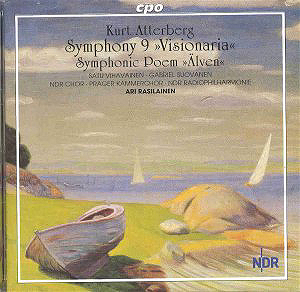With
this disc Atterberg's symphonic cycle on disc is achieved. We'll
leave out of the reckoning, for now, the highly attractive Symphony
for Strings (outside the numbered canon just like the Arnold
work of the same title). More to the point this completes the
first cycle on one label, by one conductor but with orchestral
service divided between Radio-Sinfonie-Orchester Frankfurt, Radio-Philharmonie
Hannover des NDR, SWR Radio-Sinfonieorchester Stuttgart.
Atterberg's
symphonies on record have before now been patchwork quilted across
labels. No. 2 on Swedish Society Discofil. No. 3 on Caprice (a
superb recording by the way). No. 4 is on Sterling. No. 6 is multiply
recorded on dell'Arte, Koch and most accessibly on Bis. Numbers
7 Romantica and 8 are coupled on Sterling and on CPO.
The
CPO nine are as follows and surely we can hope that they will
be issued soon as a complete boxed cycle … perhaps in 2004 to
mark the thirtieth anniversary of his death:-
Numbers
1 and 4 CPO 999 639-2
Numbers
2 and 5 CPO 999 565-2
Numbers
3 and 6 CPO 999 640-2
Numbers
7 and 8 CPO 999 641-2
Number
9 and Älven CPO 999 913-2
Piano
Concerto; Rhapsody; Ballade and Passacaglia CPO 999 732-2
After
the strongly tuneful Nordic romantic-impressionism of the earlier
scores I fear that some listeners are in for a bit of a culture
shock with the Ninth. It sounds promising. After all the text
is from the Voluspá ('The Face of the Prophetess'), part
of the Icelandic Edda - setting out their creation epic. The Vanir
and Aesir are mentioned in the sung text as are Odin, Midgård,
Yggdrasil, Heimdall, Thor, Loki and Frigg. Is this going to be
a vivid nationalistic score with elements of symphonies 3, 7 and
8 impelled into the mix? Well actually, no. The contours are instead
undulating not jagged, the approach is narrative rather than dramatic
and the music is sombre, concentrated, serious and broad. It is
determinedly tonal but it is as if the composer no longer sees
any compulsion to create magical effects or brilliance. It is
predominantly meditative with animation only entering in Med
spjut sprängde Oden, Rym styr un östern and Nu stundar
Friggas movements (trs.6, 11, 12 - the latter two being choral).
The Symphony ends after the words:-
"The
sun blackens
the
land sinks into the sea
The
sun blackens
winter's
frost in summer
From
heaven fall
flaming
stars.
...
Much
I've experienced
I
see far into the future
...
Now
the Vala is silent."
Certainly
a downbeat ending ... 'not with a bang but a wimper'. None of
the visionary exaltation of Rosenberg's Johannes Uppenbarelse,
Martinu's Epic of Gilgamesh nor the monumentalism of Goossens'
Apocalypse or Schmidt's Book with Seven Seals.
Its
performance history has been predictably sparse. The premiere
was given in Helsinki in 1957 when the conductor was Nils-Erik
Fougstedt and the orchestra was the Helsinki Symphony. There was
a performance in Dortmund in 1962 and another in Göteborg
in 1975 on the anniversary of the composer's death. A tape of
the 1957 premiere has given the symphony a kind of half-life on
the tape underground network. Michael Kube's insert note is typically
helpful and provocative comparing Visionaria with Karl
Weigl's Apocalyptic Symphony; Korngold's Symphony in F
sharp and Hindemith's Die Harmonie der Welt. The booklet
is typically helpful with the full sung text given as sung and
in English and German translation side by side.
As
contrast and salve to those bruised by the sustained sobriety
of the Symphony, Älven - från fjällen till
havet (The River - from the Mountains to the Sea) is
a symphonic poem written in the wake of the worldwide success
of the Sixth Symphony. It was commissioned by the Göteborg
Orchestral Society (who revived it in the 1980s with Norman del
Mar. It is in seven continuously-played episodes: Through mountains
and forests; The great lake; The waterfalls;
The quiet, wide stream; The harbour; View from
the mountains over the sea; Out to the sea. There is
an even more detailed verbal account given by the composer and
quoted in the booklet. The musical idiom is comparable with the
Third Symphony - alive with colour and contrast as well as being
rich in melodic resource. The music moves through filmic grandeur
to impressionistic filigree (à la Bantock's Pierrot
of the Minute), to malcontented nightmare rising to a deeply
impressive rolling brass theme more Korngold than Strauss (tr.16).
Restless activity is punctuated with a jerkily emphatic romantic
motif that suggests the Third Symphony (West Coast Pictures),
the calm star glimmer of The Harbour is made distraught
with some very 'modern' wailings and groans (Ruggles and Varèse
perhaps) disrupted by a typically twee Swedish folksong to the
proto-Delian nobility of the view from mountain eminence across
the sea's murmuring miles which in the final episode no longer
murmur but shout brassily (compare the howling gales in Bax's
November Woods) from walls of water and sing with a triumph
touched on in the very Third Symphony hinted at earlier.
I
hope that this is not the end of CPO's journey with Atterberg.
The Symphony for Strings and a Double Concerto await as
also does the Arabian fantasy opera Fanal - a work which
judging by its three Interludes (almost a symphony in their
own right) is set fair to capture hearts among those who take
warmly to Rimsky's Antar and Biarent's Contes d'Orient.
Two
quite different works juxtaposed on this disc. There is the tone
poem with some untypically avant-garde noises in the Harbour section
but otherwise vintage Atterberg (like the Third Symphony) and
an enigmatic Ninth Symphony which has little surface glamour but
promises longer terms rewards with repeated and determined listenings.
Rob
Barnett
